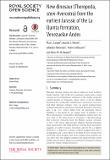New dinosaur (Theropoda, stem-Averostra) from the earliest Jurassic of the La Quinta formation, Venezuelan Andes
Author(s)
Langer, Max C.; Rincon, Ascanio D.; Ramezani, Jahandar; Solorzano, Andres; Rauhut, Oliver W. M.
DownloadLanger-2014-New dinosaur.pdf (859.3Kb)
PUBLISHER_CC
Publisher with Creative Commons License
Creative Commons Attribution
Terms of use
Metadata
Show full item recordAbstract
Dinosaur skeletal remains are almost unknown from northern South America. One of the few exceptions comes from a small outcrop in the northernmost extension of the Andes, along the western border of Venezuela, where strata of the La Quinta Formation have yielded the ornithischian Laquintasaura venezuelae and other dinosaur remains. Here, we report isolated bones (ischium and tibia) of a small new theropod, Tachiraptor admirabilis gen. et sp. nov., which differs from all previously known members of the group by an unique suite of features of its tibial articulations. Comparative/phylogenetic studies place the new form as the sister taxon to Averostra, a theropod group that is known primarily from the Middle Jurassic onwards. A new U–Pb zircon date (isotope dilution thermal-ionization mass spectrometry; ID-TIMS method) from the bone bed matrix suggests an earliest Jurassic maximum age for the La Quinta Formation. A dispersal–vicariance analysis suggests that such a stratigraphic gap is more likely to be filled by new records from north and central Pangaea than from southern areas. Indeed, our data show that the sampled summer-wet equatorial belt, which yielded the new taxon, played a pivotal role in theropod evolution across the Triassic–Jurassic boundary.
Date issued
2014-10Department
Massachusetts Institute of Technology. Department of Earth, Atmospheric, and Planetary SciencesJournal
Royal Society Open Science
Publisher
Royal Society
Citation
Langer, M. C., A. D. Rincon, J. Ramezani, A. Solorzano, and O. W. M. Rauhut. “New Dinosaur (Theropoda, Stem-Averostra) from the Earliest Jurassic of the La Quinta Formation, Venezuelan Andes.” Royal Society Open Science 1, no. 2 (October 1, 2014): 140184–140184.
Version: Final published version
ISSN
2054-5703